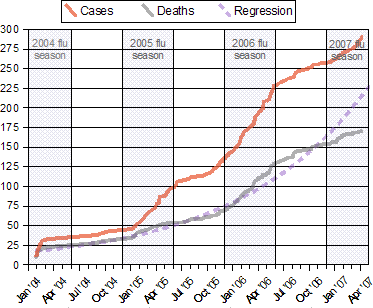It has been suggested that this article be merged into Global spread of H5N1. (Discuss) Proposed since September 2024. |
 Notes:
|
The global spread of (highly pathogenic) H5N1 in birds is considered a significant pandemic threat.
While prior H5N1 strains have been known, they were significantly different from the 2006 strain of H5N1 on a genetic level, making the global spread of this new strain unprecedented. The 2006 strain of H5N1 is a fast-mutating, highly pathogenic avian influenza virus (HPAI) found in multiple bird species. It is both epizootic (an epidemic in non-humans) and panzootic (a disease affecting animals of many species especially over a wide area). Unless otherwise indicated, "H5N1" in this article refers to the highly pathogenic 2006 strain of H5N1.
In the first two months of 2006 H5N1 spread to Africa and Europe in wild bird populations possibly signaling the beginning of H5N1 being endemic in wild migratory bird populations on multiple continents for decades, permanently changing the way poultry are farmed. In addition, the spread of highly pathogenic H5N1 to wild birds, birds in zoos and even sometimes to mammals (example: pet cats) raises many unanswered questions concerning best practices for threat mitigation, trying to balance reducing risks of human and nonhuman deaths from the current nonpandemic strain with reducing possible pandemic deaths by limiting its chances of mutating into a pandemic strain.
By April 2006, scientists had concluded that containment had failed due to the role of wild birds in transmitting the virus and were now emphasizing far more comprehensive risk mitigation and management measures.[1]
In June 2006 the World Health Organization predicted an upsurge in human deaths due to H5N1 during late 2006 or early 2007. In July and August 2006, significantly increased numbers of bird deaths due to H5N1 were recorded in Cambodia, China, Laos, Nigeria, and Thailand while continuing unabated a rate unparalleled in Indonesia. In September, Egypt and Sudan joined the list of nations seeing a resurgence of bird deaths due to H5N1; followed by Vietnam and South Korea in December.
In 2006, the World Organization for Animal Health started requiring reporting H5 and H7 avian influenza fearing pathogenic mutants. The USDA started tracking wild birds, backyard flocks, commercial flocks and live bird markets.[2]
 |
- ^ International Institute for Sustainable Development (IISD) (April 14, 2006). "Scientific Seminar on Avian Influenza, the Environment and Migratory Birds". Avian Influenza & Wild Birds Bulletin. 123 (1). Archived from the original on April 27, 2006. Retrieved September 30, 2006.
- ^ "Avian Influenza Low Pathogenic H5N1 vs. Highly Pathogenic H5N1 – Latest Update". United States Department of Agriculture (USDA). August 17, 2006. Archived from the original on April 9, 2010.